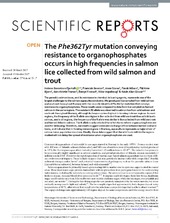| dc.contributor.author | Fjørtoft, Helene Børretzen | |
| dc.contributor.author | Besnier, Francois | |
| dc.contributor.author | Stene, Anne | |
| dc.contributor.author | Nilsen, Frank | |
| dc.contributor.author | Bjørn, Pål Arne | |
| dc.contributor.author | Tveten, Ann-Kristin | |
| dc.contributor.author | Finstad, Bengt | |
| dc.contributor.author | Aspehaug, Vidar | |
| dc.contributor.author | Glover, Kevin | |
| dc.date.accessioned | 2018-01-04T13:29:32Z | |
| dc.date.available | 2018-01-04T13:29:32Z | |
| dc.date.issued | 2017-10-27 | |
| dc.Published | Fjørtoft HB, Besnier F, Stene A, Nilsen F, Bjørn Pa, Tveten A, Finstad B, Aspehaug V, Glover KA. The Phe362Tyr mutation conveying resistance to organophosphates occurs in high frequencies in salmon lice collected from wild salmon and trout. Scientific Reports. 2017;7:14258 | eng |
| dc.identifier.issn | 2045-2322 | en_US |
| dc.identifier.uri | https://hdl.handle.net/1956/17125 | |
| dc.description.abstract | The parasitic salmon louse, and its resistance to chemical delousing agents, represents one of the largest challenges to the salmon aquaculture industry. We genotyped lice sampled from wild salmon and sea trout throughout Norway with the recently identified Phe362Tyr mutation that conveys resistance to organophosphates. These results were compared to data from lice sampled on farmed salmon in the same regions. The resistant (R) allele was observed in salmon lice from wild salmon and sea trout throughout Norway, although its frequency was highest in farming-intense regions. In most regions, the frequency of the R allele was higher in lice collected from wild sea trout than wild Atlantic salmon, and in all regions, the frequency of the R allele was similar in lice collected from wild sea trout and farmed Atlantic salmon. The R allele is only selected for in fish-farms where organophosphates are used for delousing. Therefore, our results suggest extensive exchange of lice between farmed and wild hosts, and indicate that in farming-dense regions in Norway, aquaculture represents a major driver of salmon louse population structure. Finally, these data suggest that the wild hosts within the regions studied will not delay the spread of resistance when organophosphates are used. | en_US |
| dc.language.iso | eng | eng |
| dc.publisher | Nature Publishing Group | en_US |
| dc.rights | Attribution CC BY | eng |
| dc.rights.uri | http://creativecommons.org/licenses/by/4.0 | eng |
| dc.title | The Phe362Tyr mutation conveying resistance to organophosphates occurs in high frequencies in salmon lice collected from wild salmon and trout | en_US |
| dc.type | Peer reviewed | |
| dc.type | Journal article | |
| dc.date.updated | 2017-11-02T09:04:10Z | |
| dc.description.version | publishedVersion | en_US |
| dc.rights.holder | Copyright 2017 The Author(s) | en_US |
| dc.identifier.doi | https://doi.org/10.1038/s41598-017-14681-6 | |
| dc.identifier.cristin | 1510132 | |
| dc.source.journal | Scientific Reports | |

